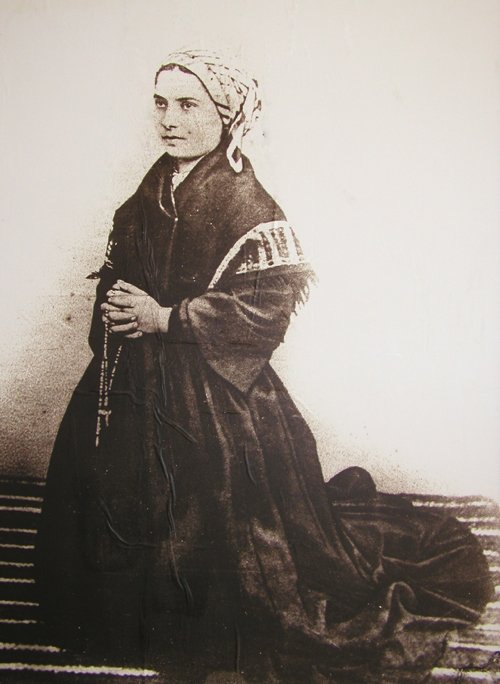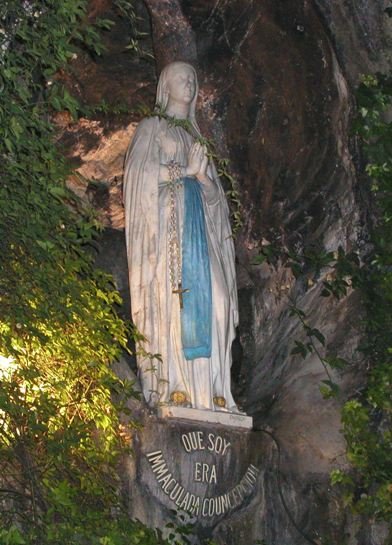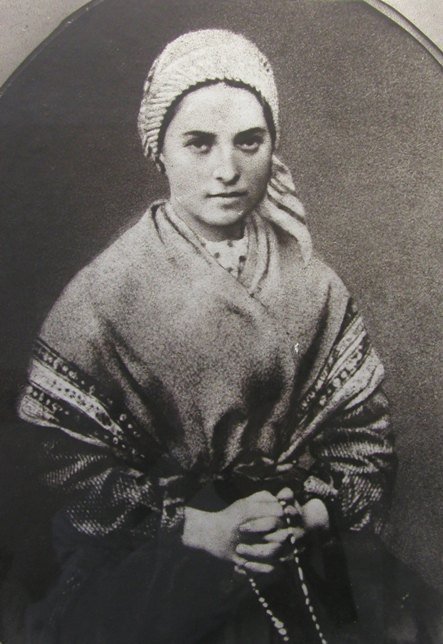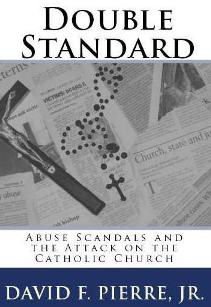 By Father Francis Spirago
By Father Francis Spirago From Father Francis Spirago's Anecdotes and Examples Illustrating the Catholic Catechism (New York: Benziger Brothers, 1904), 187-188
 By Father Francis Spirago
By Father Francis Spirago 

 The true image of Our Lady of Guadalupe.
The true image of Our Lady of Guadalupe.
 Deputy Director McCarthy showed the national projection of the controversy by admitting that the museum received over 65,000 “Enough is enough!” protest postcards from the TFP effort. They were still coming months after the exhibit came down.
Deputy Director McCarthy showed the national projection of the controversy by admitting that the museum received over 65,000 “Enough is enough!” protest postcards from the TFP effort. They were still coming months after the exhibit came down. Written by Plinio Corrêa de Oliveira
Written by Plinio Corrêa de Oliveira |
| Photo of Saint Bernadette Soubirous. Her whole expression is one of complete detachment. She was completely humble, and her goal was to go about the service of Our Lady without caring about what others thought. |
 |
| Our Lady of Lourdes in the grotto where she appeared to Saint Bernadette and declared “I am the Immaculate Conception.” |
 |
| Through Our Lady, Saint Bernadette acquired a love for suffering and of the Cross of Christ. She offered her life as an expiatory victim for sinners, but above all for a mysterious sinner who she did not name. |
BRUSSELS, Belgium, (LifeSiteNews.com) – Archbishop Andre-Joseph Leonard of Brussels was hit in the face with custard pies by homosexual activists who oppose what the head of the Belgian Catholic Church has said about homosexuality.
The archbishop, widely recognized to have been installed in Belgium by Pope Benedict XVI to reform the liberal Belgian Church, which has been riddled with covered-up homosexual abuse scandals, has been verbally and physically attacked, and ostracized for his staunch orthodox Catholicism.
This week, a well-known Belgian prankster, known as “The Glooper,” who has targeted French President Nicolas Sarkozy and Microsoft founder Bill Gates in the past, posted videos of the pie attacks on YouTube.
At least four pie attacks took place before and during the archbishop’s speaking presentation at the renowned liberal Catholic University of Louvain-la-Neuve near Brussels.
This is the second time that Archbishop Leonard has been attacked with pies by homosexual activists. In December 2010, a man ran up to the archbishop during a service at the Brussels cathedral and shoved a cherry pie in his face, apparently in connection with his statements on homosexuality.
All the incidents stem from comments Leonard made in a book released last October, in which he said that AIDS is a consequence of risky sexual behavior, including homosexual sexual activity. “AIDS at the beginning multiplied through sexual behaviour with all sorts of partners or else through anal rather than vaginal sexual rapports,” said Leonard.
“When you mistreat the environment it ends up mistreating us in turn,” he continued. “And when you mistreat human love, perhaps it winds up taking vengeance … All I’m saying is that sometimes there are consequences linked to our actions. I believe this is a totally decent, honourable and respectable stance.”
In December, Leonard was targeted by homosexualist groups, condemned by the country’s prime minister, and distanced by his fellow bishops. A lawyer, acting on behalf of a homosexualist lobby group, filed a formal complaint against Leonard for “homophobic statements” and “violating an anti-discrimination law.” Academics at the University of Louvain-la-Neuve, where his talk took place earlier this week, circulated a petition at the time calling for Leonard’s resignation from his post as the university’s chancellor.
“There is in the homosexual tendency and practice an orientation that is not coherent with the objective logic of sexuality,” he wrote at the time.
Archbishop Leonard has also been attacked for his views on abortion. A key speaker at last year’s March for Life in Belgium, Leonard has been an enthusiastic supporter of the pro-life initiative.
The activists who attacked the archbishop with pies said it was precisely for such views that they were targeting Leonard. One of them reportedly told Belgian media, “for all those homosexuals who daren’t tell their parents they are gay, for all those young girls who want to have an abortion, he absolutely deserved it.”
(LifeSiteNews.com) - The Catholic archbishop of Santa Fe has issued a pastoral letter, read in all parishes of the archdiocese on April 3, that explains the Catholic Church’s position on reception of the sacraments to those living in cohabitation.
“We are all painfully aware that there are many Catholics today who are living in cohabitation,” the pastoral letter by Archbishop Michael Sheehan begins. “The Church must make it clear to the faithful that these unions are not in accord with the Gospel, and to help Catholics who find themselves in these situations to do whatever they must do to make their lives pleasing to God.”
The Gospel teaches that, when it comes to sexual union, “there are only two lifestyles acceptable to Jesus Christ for His disciples: a single life of chastity, or the union of man and woman in the Sacrament of Matrimony,” the archbishop states. “There is no ‘third way’ possible for a Christian. The Bible and the Church teaches that marriage is between one man and one woman and opposes same sex unions.”
In the short and concise pastoral letter, Archbishop Sheehan explains the objection of the Church to the “three groups of people who are living contrary to the Gospel teaching on marriage” receiving Communion.
These three groups are those who cohabit; those who have a civil union with no sacramental marriage; and those who have a civil union who were married before.
“These people are objectively living in a state of mortal sin and may not receive Holy Communion. They are in great spiritual danger. At the best - and this is, sadly, often the case - they are ignorant of God’s plan for man and woman. At the worst, they are contemptuous of God’s commandments and His sacraments.”
The solutions available to these people are straightforward, according to the archbishop.
“Of these three groups, the first two have no real excuse. They should marry in the Church or separate.”
“The third group, those who were married before and married again outside the Church, can seek a marriage annulment and have their marriage blest in the Church. Please remember that divorce still is no reason to refrain from Holy Communion as long as they have not entered into another marriage or sinful relationship. Many Catholics are confused on this point.”
Archbishop Sheehan also states that people in these three situations may not be commissioned as Extraordinary Ministers of Holy Communion, nor be admitted to the role of sponsor for Baptism or Confirmation.
“It is critical for the sponsor to be a practicing Catholic - and can anyone be seriously called a practicing Catholic who is not able to receive the sacraments because they are living in sin?” the archbishop posits.
“Many of these sins are committed out of ignorance,” Archbishop Sheehan observes, adding, “I ask that our pastors preach on the gravity of sin and its evil consequences, the 6th and 9th Commandments of God, and the sacramental nature and meaning of Christian marriage.”
“I urge especially young people to not cohabitate which is sinful, but to marry in the Church and prepare well for it,” the archbishop concludes.
The full text of Archbishop Sheehan’s pastoral letter, titled, “Pastoral Care of Couples Who are Cohabitating” is available here.

Written by Plinio Corrêa de Oliveira
This photograph is of Saint Gemma Galgani (1878-1903), a famous mystic who lived in the enchanting town of Lucca, Italy.
Her countenance is impressive for several reasons. First, we note her profound reflection and the harmony of her traits. Second, the saint’s gaze has something elevated and sublime about it. Her thoughts are not of this earth: her countenance displays a supernatural aura.
Her dignity and angelic purity are striking. This is seen by the way her head rests on her shoulders: straight and unpretentious.
She wears no adornment at all. Her hair is simply combed and arranged. Her face is very clean and reveals nothing of a desire for embellishment.
Her dress is black and simple. Yet, St. Gemma combines an extraordinary dignity with a virginal purity which is impalpably reflected in the luminous splendor of her skin. One could say that her skin is as luminous as her gaze. Moreover, her gaze reflects total uprightness. It is that of a mystic immersed in that which she sees. Even we discern something of what she perceives.
The virtue of fortitude also shines forth in her countenance. When the Faith commands her to do something, her will is unbending.
What does she desire? She wants to serve God, Our Lady and the Catholic Church. She forges ahead on this road regardless of the obstacles. She represents the strong woman of incomparable values referred to in Holy Scriptures. Like a rare stone, one readily walks to the ends of the earth to find her.
Her feast is on April 11.
(Published in the August 1999 issue of Catolicismo)

 by John Horvat II
by John Horvat II |
 by John Horvat II
by John Horvat II